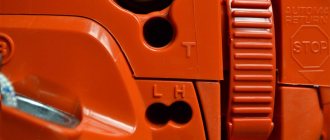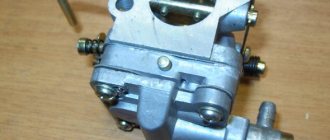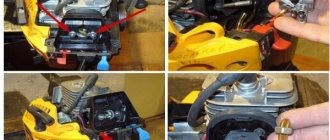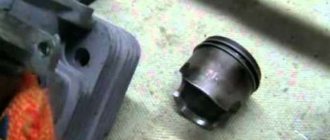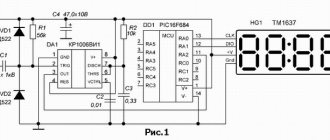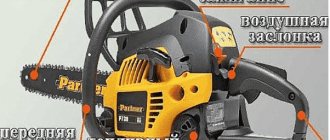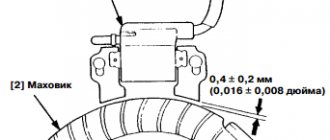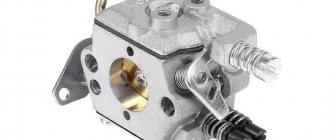Adjusting a chainsaw carburetor - when is the procedure required?
- The engine does not start at all, or stalls immediately after starting - the reason for this may be a shortage of fuel coupled with an excess of air;
- Increased fuel consumption - in this case, the amount of exhaust gases rapidly increases. The reason for this situation should be sought in an increase in the amount of fuel and a decrease in the amount of air;
There are also a number of mechanical reasons that lead to the need to adjust the carburetor. These include:
- Strong vibration - it leads to damage to the protective cap, resulting in loss of fixation of all three adjusting screws;
- Wear of the piston part of the engine - in such a situation, adjusting the carburetor will only temporarily prolong the operation of the tool. To completely eliminate the problem, you will have to completely replace the piston group;
- The formation of blockages - they appear as a result of the use of low-quality gasoline, damage to the filter or scale. In such cases, it will be necessary to dismantle, disassemble and clean the carburetor.
In any of the above cases, it is better not to delay the procedure for adjusting or flushing the unit. Otherwise, this will lead to damage to other equally important elements of the chainsaw.
How to recognize carburetor failures?
Typical carburetor malfunctions are easy to recognize. They are expressed in the fact that the chainsaw engine starts and immediately stalls or shows no signs of life at all. Well, or it consumes fuel with all its might, producing clouds of black smoke and aggressive vibrations instead of the required power.
Operation diagram of a chainsaw carburetor
Carburetor settings may be affected by:
- lack of fixation of the adjusting screws;
Chainsaw adjustment screws
New CPG chainsaw Husqvarna 365
Chainsaw air filter with nylon insert
Any problems found should be corrected immediately. But how can you determine that the problem is in the carburetor? To do this, watch how your tool works.
Typical signs that the carburetor settings are off include:
- Unstable motor operation
As a rule, the reason for this is the use of the wrong (lean) fuel mixture.
- Excessive fuel consumption
It is expressed in an increased release of exhaust exhaust, which turns black. This means that fuel is not completely consumed, i.e. the mixture is oversaturated.
The carburetor is adjusted correctly - the saw starts the first time
- Arbitrary changes in engine power
May be associated with damage to the fastening of the adjusting screws or the protective cap.
- Increased fuel consumption accompanied by vibrations and pops
This indicates critical wear of the piston group, so adjusting the carburetor will only postpone major repairs for some time.
- Sneezing and engine jerking
This picture is observed when the carburetor channels are clogged or its filters are faulty. In this case, adjustment should be carried out only after thoroughly washing the unit.
Chainsaw fuel filter
Despite the fact that the carburetor is the most complex part of the engine, you should not be upset if you detect malfunctions in its operation. Instead, you need to arm yourself with some tools, a design diagram of the unit and sound logic.
Chainsaw carburetor being repaired
Chainsaw Husqvarna 142 - features of operation and maintenance
The Husqvarna 142 chainsaw is used for work in the garden and at the dacha; it is an excellent option both for felling trees and for collecting firewood. The Husqvarna 142 chainsaw has technical characteristics that provide maximum performance and safety. The engine speed reaches nine thousand units per minute. The cylinder size is nominally 40.2 cm³. The fuel tank capacity is 410 ml and the oil tank is 200 ml. It is worth considering that the noise level is 118 dB. The mass of the unit is 4.6 kilograms. The length of the tire is from 33 to 38 centimeters, the chain pitch is 0.83 centimeters.
Advantages of the model
- The relatively light weight of the Husqvarna 142 chainsaw and the ergonomic design, combined with the curved front handle, make the operation of the equipment as comfortable as possible.
- The anti-vibration system allows you not to feel tired for a long time.
- A guard and chain brake are provided to ensure user safety.
- The power of the Husqvarna 142 chainsaw is increased through a forged crankshaft consisting of three sections.
Possible malfunctions of the Husqvarna 142 chainsaw
Like any other devices whose operation is associated with intense loads and difficult conditions, Husqvarna 142 chainsaws can fail, and the causes of problems can be divided into two groups:
- Engine or piston group failure. Problems with the fuel, exhaust or ignition system.
- Problems that have arisen in mechanical components - tire, clutch, brake or lubrication systems.
Engine
Engine breakdown is one of the most common and time-consuming. This problem is manifested by the following factors:
- Unstable operation at idle.
- Does not start.
- There is not enough power, or the Husqvarna 142 chainsaw starts and stalls as soon as it starts to pick up speed.
Before you begin repairing the Husqvarna 142 chainsaw, it is recommended to conduct a complete diagnosis of the equipment to accurately determine the causes of the problems.
The reason why the Husqvarna 142 chainsaw does not start
If the Husqvarna 142 chainsaw does not start, there may be several reasons. The most common ones include the following:
- Damage to spark plugs - to understand whether a spark plug is working properly, you need to unscrew it and inspect it. If the porcelain insulator has cracked, you see a burnt or damaged electrode, you should immediately replace the spark plug. In addition, after working for several seasons, the Husqvarna 142 chainsaw requires inspection of spare parts. Spark plugs also wear out their lifespan, and to ensure the safety of the saw, replace them with new ones.
- Carburetor clogged - during operation, gradually, fuel vapors settle on the internal walls, forming a sticky consistency that can clog the carburetor, preventing the engine from starting. You will need to clean it with a special detergent. When repairing a Husqvarna 142 chainsaw, carburetor adjustment is always carried out with a warm engine and cleaned systems.
- Malfunction of the ignition coil - before you decide to replace this part, make sure that the spark plugs meet the required technical condition.
How to adjust the carburetor of a Husqvarna 142 chainsaw
Adjusting the carburetor of the Husqvarna 142 chainsaw should be done with the engine warm
Pay attention to the condition of the air filter, which will need to be cleaned if necessary and make sure it is not clogged. Adjusting the carburetor of the Husqvarna 142 chainsaw with your own hands is done using three screws:
- L – for low engine speeds.
- H – for high engine speeds.
- T – for idle speed.
Turn the low and high speed control screws clockwise to the limit, and after the peak is reached, turn them in the opposite direction, one and a half turns. When idling, the Husqvarna 142 chainsaw chain must be stationary. Check at maximum speed.
You can avoid most malfunctions and costly repairs by following the manufacturer’s instructions and recommendations, as well as using original spare parts for the Husqvarna 142 chainsaw.
comments powered by HyperComments sadovij-pomoshnik.ru
Chainsaw malfunctions and their elimination
There are typical faults that owners of the Husqvarna 137 model most often encounter. In order to be able to fix them yourself, you need to study the signs of their occurrence and effective methods for repairing them.
The chainsaw stalls at full throttle - how to solve the problem?
The cause of this breakdown is most often the spark plug flooding at the moment when the engine begins to quickly gain speed. To fix the damage, you should unscrew and clean the spark plug, and then dry it completely. Next, you need to drain the remaining fuel through the spark plug hole. At the end, you need to screw the spark plug back into place and try to start the tool again.
Another common cause of failure is lack of spark. Repairs should begin by inspecting the contact between the high-voltage wire and the tip of the spark plug. If the contact is not broken, and the saw still stalls when you press the gas, then you should inspect the electronic ignition unit. This unit cannot be repaired, so it will have to be replaced entirely.
Replacing the Husqvarna 137 sprocket
It is necessary to change the Husqvarna 137 sprocket if, when the engine reaches medium speed, the engine begins to stall.
As indicated in the operating instructions, the procedure should look like this:
- First you need to remove the cylinder cover and unscrew the spark plug;
- Next, you need to take a plastic or metal stopper for the motor piston, as well as a key for dismantling the centrifugal mechanism. Using a key, you need to twist the centrifugal mechanism in the direction in which the chain rotates;
- Then you need to inspect the clutch disc. If only the sprocket is faulty, then only it needs to be replaced. If the entire clutch disc is completely broken, along with the springs and cams, then the entire disc will have to be replaced;
- After this, you need to install a new clutch disc. To clamp the centrifugal mechanism on the motor shaft, you will need to unscrew the piston stopper and pull the starter cord towards you. Then you need to screw the stopper all the way;
- Next, you will need to clamp the centrifugal mechanism with a key in the direction against the rotation of the chain.
After completing all of the above steps, you will need to start the saw and let it idle for 1-2 minutes. This is necessary to warm up the engine and grind in the new clutch disc. You can then continue working with the tool.
Instructions for setting up and adjusting yourself
Before moving on to setting up the Husqvarna 137 chainsaw, it is necessary to install it. Before starting work, you need to study the structure of the Husqvarna 137 chainsaw.
Be sure to wear gloves for protection. They are not included in the package, so you need to take care of purchasing them in advance. First you need to install the saw comb and secure it with two screws. If chains and bars are not installed, they should also be put in their place. To do this, you need to remove the cover and the nuts securing it. If there is a shipping pad on the chain, it must be removed.
Adjust the chain tension using the adjusting screw
It is important that the gripper can fit into the hole in the tire. To advance the grip, you need to turn the adjusting screw counterclockwise.
This way you can achieve the correct grip position. Next you need to prepare the circuit for installation. To do this, its correct position is selected. A sprocket is placed on the chain, which is located behind the clutch drum. The chain is passed between the teeth of the sprocket. The upper part of the guide bar must be moved into the groove of the guide bar that surrounds it.
Hold the guide bar relative to the chainsaw body to install the clutch cover.
The adjusting nuts are then inserted and tightened by hand. Once the chains have been fully adjusted, they can be fully tightened. You can find out how to adjust the carburetor in the instructions attached to this saw model. Tuning a Husqvarna 137 carburetor usually does not cause any problems.
When the installation is completed, you can proceed to setting up the Husqvarna 137 chainsaw.
- First you need to set the saw switch to the “On” position.
- Then pull the idle air damper lever all the way.
- Pull the starter cord with a sharp movement of your hand (but no more than ten times).
If the sound of the engine is heard before you have completed the 10th dash, you can move on to the next step.
Next, you need to move the lever to switch modes to the “HalfChoke” position. This will mean that the air damper will be half closed. Next, you need to jerk the starter cord until the engine starts. After starting the engine, you need to let it run for about five seconds. The engine starter must then be pressed and released to return the engine to idle speed.
To start and configure an already warmed-up engine, you need to:
- Set the saw switch to the “On” position.
- Direct the mode change knob towards o.
- With your right hand you need to pull the cord until the engine starts running.
- Press the engine starter until it returns to idle speed.
Watch the video for the disassembly and assembly process:
Carburetor tuning: main points
Reassembly of the carburetor is carried out only after complete cleaning, drying and blowing with compressed air. However, do not forget that some gaskets and seals, even if there is no damage, must be replaced.
You can begin adjusting the carburetor if it is correctly troubleshooted, of high quality assembly and flawless re-installation on the engine.
Principles of carburetor tuning:
- screws H and L adjust the ratio of air and fuel mixture, i.e. throttle position. Tightening the screws clockwise leads to a lean mixture and the engine switches to low speeds. When unscrewing (counterclockwise), the mixture becomes richer and the engine speed increases;
- screw T is responsible for adjusting the idle speed: turning it clockwise increases their number, counterclockwise - decreases it;
- The screws are adjusted in LHT order.
Chainsaw carburetor calibration
The general adjustment algorithm looks something like this:
- Initially, the highest idle speed is found by turning screw L and then returning ¼ turn counterclockwise. If the chain rotates at idle, turn screw T in the same direction until it stops completely.
- With the engine warm and running at full speed, turn screw H ¼ turn to the left, then let the engine run for 10 seconds and check the maximum speed using a tachometer. It must correspond to the number indicated in the instrument passport.
- After calibration with screws L and H, using screw T, the idle speed is adjusted. If everything is done correctly, the engine will operate evenly in all its positions.
Reminders for calibrating the carburetor on the chainsaw body
Upon completion of the adjustment, all that remains is to reinstall the chainsaw cover with the insulating gasket, after which you can begin the main work. If the settings are correct, the chainsaw engine will receive the optimal fuel mixture. This will ensure its normal efficiency, as well as overall comfort and safety of working with the tool.
Problems with the fuel supply system
If the tool does not work, this may be due to the fact that fuel is not entering the cylinder. First of all, you need to check the fuel filter for contamination levels. To check this, you need to remove the fuel hose and check how fast the fuel flows.
If it is supplied under low pressure, then the problem lies in the filter.
In this case, you need to clean the filter. It is taken directly through the tank. The filter is cleaned and installed back. It is washed under running clean water.
After this, the filter is dried and carefully installed back. To prevent this problem from occurring in the future, it is necessary to periodically clean the filter.
If cleaning the filter does not give a positive result, then you should pay attention to the breather. A clogged hole in this hole causes insufficient air to enter the carburetor.
Expert advice: when troubleshooting such faults, you must use the instructions, this will prevent more serious breakdowns from occurring.
Chinese equivalent
On the market you can see a cheaper version of the chainsaw with indexation 365 XP, but it has nothing in common with the Swedish company. This is an analogue counterfeit made in China. What makes it stand out is not only its cheapness, but also its low quality. In order not to make a mistake in your choice when purchasing, it is recommended to pay attention to the following points:
Husqvarna 365 XP
- there is no metal nameplate indicating the model and its number;
- the fuel filter differs in shape and parameters from the original;
- There are no fastening latches on the filter cover.
When buying a chainsaw, price should not influence your choice. The main attention should be paid to the quality and originality of the product. Only this will ensure durability and reliable operation.
DIY carburetor repair
If, during a full diagnosis of the Husqvarna chainsaw, carburetor defects were discovered, some of them can be eliminated without contacting the Husqvarna AB service center. For example, you can do this yourself:
- change the gaskets under the covers of the main chamber and fuel pump;
- clean or replace the strainer;
- replace the diaphragm or needle valve of the main chamber;
- troubleshoot the fuel pump diaphragm.
Gaskets, diaphragms and a needle valve with a rocker arm can be found in the repair kit, which is available for each model of Husqvarna chainsaw carburetors.
Also, if you have some experience, you can try to restore a faulty injector valve, but you cannot guarantee a positive result when trying to restore an injector; if it malfunctions, manufacturers recommend replacing the carburetor completely.
How to install the repair kit?
If the problem affects the carburetor nozzle, you can try to fix the serious problem yourself. However, the manufacturer recommends dealing with this problem only by replacing the unit.
To remove the carburetor, you need to completely clear the saw of sawdust and shavings. To do this, you need to use a compressor and a compressed air gun. Next, unscrew the filter cap and remove the filter element. After this, all drives and throttle linkages are disconnected from the Husqvarna carburetor. Now you can remove the carburetor from the saw.
Next, you need to completely disassemble the carburetor and replace all the elements that the repair kit offers. Namely, spare parts and gaskets. This will save you from breakdowns in the future.
Now you know how to adjust the carburetor of the famous Husqvarna 137 chainsaw.
Chainsaw operating instructions
The Husqvarna 137 chainsaw, like other models of this brand, is equipped with an inertial automatic chain brake. This part was invented by engineers working at Husqvarna. Nowadays, most manufacturers still produce chainsaws with contact brakes. That is, the brake is activated when interacting with the hand during a reverse impact. In practice, such a contact brake may not work at all. Don’t forget to take care of your engine; to learn how to dilute gasoline with chainsaw oil, read this article.
The autovibration system of this model operates on the principle of “two masses”. The manufacturer does not produce other systems.
Husqvarna 137 is equipped with a high-profile professional chain (like a Stihl chainsaw). This is another difference from chainsaws with low profile chains. Chainsaws with high-profile chains have a forty percent higher chain. This is especially noticeable with large volumes of work. In addition, such chainsaws maintain high performance even when working with contaminated wood.
One of the most common mistakes when starting a Husqvarna 137 is closing the air damper without turning on the ignition.
It turns out that the fuel mixture enters the cylinder. But there is no spark, no ignition occurs. After this, you will have to unscrew the spark plug, wipe it and screw it back in. Therefore, it is worth remembering that all Husqvarna chainsaws have a combined damper, and the ignition in them will be turned on automatically at the moment when the damper lever is pulled out. There shouldn't be any errors.
Advantages and disadvantages
The Husqvarna 137 chainsaw, like any product, has pros and cons.
The advantages of the tool are as follows:
- high quality of manufacturing and fitting of parts together;
- use of wear-resistant materials, long service life;
- convenient design that provides balance when working;
- light weight of the product, use of durable polymer plastic;
- safety ensured by several safety devices;
- high performance;
- affordable cost of tools and consumables.
The product has practically no disadvantages. It is necessary to use high-quality fuels and lubricants and observe the proportions for preparing the fuel mixture. If this is not done, the tool will fail.
Evaluation parameters and scope of application
The tool's high center of gravity, narrow configuration and flat body bottom contribute to the slow accumulation of fatigue. The user rating obtained during the survey is evidence of the high reliability, power and versatility of the model.
For a 10-point scale, the average was 8.3.
The characteristics of the tool determine its use in a wide range of household works, including:
- firewood preparation;
- preparation for installation of construction timber;
- formation of crowns of ornamental and fruit trees;
- independent production of wooden items for interior design and landscape design.
The saw successfully copes with single-pass, standard, longitudinal and diagonal sawing of hardwood with a diameter of up to 30 cm. The compact design makes it possible to work in hard-to-reach places, which is especially valued in construction technologies.
MAINTENANCE OF HUSKVARNA CHAINSAW 137
Chainsaw service and repair require special training. The manufacturer recommends contacting a specialized service center for professional repairs.
The motor on the chainsaw does not start. Causes:
- Ignition
- Engine is flooded
- Fuel tank is empty or fuel does not reach carburetor
- Spark plug won't ignite
The engine does not work well at idle. Causes:
- Carburetor needs adjustment
- Crankshaft insulation worn
The motor does not gain speed, loses power or stops, unable to withstand the load. Causes:
- The air filter is dirty
- The spark plug is dirty
- Carburetor needs adjustment
Smoke is coming from the engine. Causes:
Too much oil mixed with gasoline
Air filter for Husqvarna 137 chainsaw
A dirty air filter reduces engine power and increases fuel consumption and emissions. It must be cleaned after every 5 hours of operation.
Tire care
The tire needs maintenance or replacement if
- Saw with only one side of the saw
- Working with an amount of lubricating oil that does not meet the recommendations
It is necessary to replace the tire if it is deformed or the inner grooves of the tire are worn. Be sure to clean the oil supply holes every 5 hours of operation. Regularly and carefully remove dirt from the tire groove using a wire or putty knife.
Spark plug
Replace your spark plug every year using the Champion RCJ7Y. The correct gap is 0.5 mm.
carries out scheduled and emergency repairs, as well as maintenance of chainsaws in accordance with the recommendations of equipment manufacturers.
Nuances of adjustment
After the adjustment, the chainsaw should easily pick up and drop speed, and operate stably at low and high speeds. If the saw chain rotates at idle speed after adjusting the carburetor control screws, this is a sign that the adjustment was made incorrectly and the position of the screw (T) needs to be adjusted.
Also, when adjusting the Husqvarna carburetor, it is worth taking into account the response time of the chainsaw to the rotation of the screws. The settings do not change immediately, but within five or ten seconds.
One of the indicators of incorrect adjustment is heavy smoking when the saw is operating, which indicates a large amount of fuel entering the combustion chamber. If such a situation occurs, the position of the screw (L) must be adjusted.
Device, tool maintenance instructions
Design of the Husqvarna 137 chainsaw: the simple design of the chainsaw consists of a block with a two-stroke engine, an air cleaner, a clutch, a fuel and oil reservoir and a guide bar with a cutting chain. Both the chain and the tire are replaceable equipment, completely replaceable with analogues after final wear (installation of components 15 and 13 inches long is allowed).
Fuel and oil, lubricants for husqvarna 137
The Husqvarna chainsaw engine is designed to run on unleaded gasoline. The best choice for this model is AI-95 or AI-92 gasoline. The ratio of gasoline to oil is 40:1, resulting in a 2.5% mixture for the operator. The fuel is mixed separately, in a special clean mixing container.
Oil recommended for Husqvarna chainsaw engine: manufacturer’s recommendation oil for two-stroke air-cooled Partner engines or original Husqvarna. Also use specific oil from Husqvarna or Partner to lubricate the bar and chain.
Oil for two-stroke engines PARTNER Oil Husqvarna HP 2-stroke
Duration of operation of the Husqvarna 137 chainsaw
The average operating time of a Husqvarna chainsaw on one refill is 30-40 minutes, depending on the degree of load. After running out of fuel, if you need to continue working, turn off the engine, let it cool and refuel the tool.
The main causes of malfunctions of the Husqvarna 137 chainsaw and how to eliminate them
Table 1. Causes of husqvarna 137 malfunctions and how to resolve them
| Malfunction | Cause | Remedy |
| The chainsaw suddenly begins to stall during operation, loses power, and refuses to turn on. | There may be a violation in the piston group; carburetor adjustment or engine maintenance is necessary. | It is not recommended to replace the piston and other components of the piston group yourself; contact the service center specialists. |
| The chain moves when the motor is idling. | The chain should not move when the engine is idling, but if it does, the cause is probably in the carburetor. | It is necessary to adjust the carburetor, perhaps change the chain. |
| The engine does not start, stalls immediately after starting. | Cold weather, choke lever not extended, engine not warmed up. Excess fuel (tank full). | Start according to the instructions, with the choke pulled out. Pour off some of the fuel. |
| The chainsaw smokes while working and then stalls. | Excess oil. | Fill in oil no more than the recommended rate for this model. |
| Gasoline does not flow from the chainsaw tank to the engine. | The breather is clogged and needs cleaning or replacement. | The breather replacement is carried out by service center specialists or by the owner himself if the chainsaw is not under warranty. |
HUSQVARNA
Technical specifications Husqvarna 372 XP
Engine's type. Gasoline Cylinder displacement, cubic cm, 70.7 cm3 Maximum power, kW. 3.9 kW (9600 rpm) Rated power at operating speeds, hp 5.3 hp (9600 rpm) Idle speed. 2700 rpm Spark plug. Champion RCJ7Y 5776166-02 (61141), Husqvarna HQT-1 5774840-01 (63893), NGK BPMR7A Interelectrode gap. 0.5 mm Fuel tank capacity 0.77 l Torque, max. 4.3 Nm / 6600 rpm Chain lubrication tank capacity. 0.4 L Lubrication circuit pump type. Adjustable flow Chain pitch. 3/8 inch chain thickness. 1.5 mm / 0.058 in. Bar length included. 45 cm / 18 inches Recommended bar length, min-max 38-71cm / 15-28 inches Chain rotation speed to maximum. it turns out. 21.4 m/s Equivalent vibration level, front/rear handle. 3.5 / 4.0 m/s2 Guaranteed sound power, dB (A). 115 Weight (without cutting equipment), kg. 6.1 kg
A chainsaw is needed in construction, gardening, and landscaping - its presence greatly simplifies the performance of a number of wood processing tasks. The main component of this tool is the engine, the operation of which largely depends on the condition and settings of the carburetor. This is where the fuel mixture is prepared. This means that if the saw does not start, stalls, or does not provide the required power, it is likely that the reason for this is improper operation of the carburetor. Fortunately, in many cases you can deal with this on your own. Only for this you need to know and understand the structure and operating principle of this unit and, of course, the chainsaw itself.
Adjusting the Carburetor of the Husqvarna 137 Chainsaw
Description of the process of adjusting the carburetors of Husqvarna chainsaws. The main obstacles that can be solved using the option of fuel properties and quantity.
Modern chainsaws have a complex system and consist of several main components, which at times require maintenance and adjustment. In this article we will talk about how to adjust the carburetor
on a Husqvarna chainsaw.
In what cases does the carburetor of a Husqvarna chainsaw require adjustment?
Problems that can be solved by adjustment
carburetor, quite a lot. Adjusting the carburetor of the Husqvarna chainsaw is necessary when defects such as:
- High idle speed;
- Strong smoke when operating the tool;
- Difficulty starting a cool or hot engine;
- Lack of traction and reduced maximum speed.
This is by no means a complete list of problems that can be solved by tuning the Husqvarna carburetor. In a number of different cases, adjusting the properties and amount of fuel consistency is carried out after a half-year engine repair or during scheduled maintenance of the chainsaw.
The manufacturer Husqvarna AB recommends adjusting the carburetor before and after break-in.
The design and principle of operation of the Husqvarna carburetor
For successful implementation of the chainsaw carburetor
Husqvarna should know its structure and be aware of how it works. In fact, everything is not as difficult as it seems at first glance.
The saw carburetor has an integrated fuel pump, which is responsible for transporting the mixture of gasoline and oil, as well as a diaphragm, a needle valve with a rocker arm. Their joint work allows the fuel supply to be dosed into the main chamber and two dampers.
One of the dampers is designed to regulate the flow of fuel into the cylinder when you press the gas, it is called the throttle, the second is responsible for limiting the flow of air from the air filter to facilitate starting a cool Husqvarna chainsaw. At the moment when the operator shuts off the air supply to the carburetor using the air damper, the fuel consistency becomes depleted and its supply to the cylinder increases, due to which the chainsaw
it starts much easier than in this case, when a cool start is carried out in normal mode.
The operation of the Husqvarna carburetor involves a valve-nozzle, which sprays fuel and ensures the flow of air into the main chamber. Often, difficulties when operating a saw can be caused by shortcomings of this particular element. For example, if the chainsaw is stored incorrectly, the valve may stick, the fuel supply will end, which will make the engine impossible to operate. Also, malfunctions in the operation of the nozzle can cause air to leak into the main fuel chamber of the carburetor. In such cases, adjusting the position of the adjusting screws will not correct the situation; it will be necessary to carry out repairs or replace the unit.
Tools required for work
Before you start setting up the Husqvarna carburetor, you need to make sure you have all the tools that may be useful. To carry out this type of work yourself, you will need:
- screwdriver for adjusting screws (H) and (L), in specialized stores they have very high prices, so we recommend buying such screwdrivers as a set from Aliexpress; in our service we use such a set;
- electronic tachometer to determine crankshaft speed readings (with some experience, you can adjust by ear), in our tool repair service we use a high-quality and inexpensive analogue, which can be ordered on aliexpress using this link;
- Phillips screwdriver , for adjusting screw (T);
- compressor with a blow gun for cleaning the saw before work.
A regular slotted screwdriver will not work for adjustment , since the adjustment screws on Husqvarna chainsaws can have a different cross-section. You will have to purchase a special one, this is a feature of repairing Husqvarna chainsaws; they did everything so that the saw could be repaired only in a specialized Husqvarna service center.
Adjusting the Carburetor of the Husqvarna 137 Chainsaw
How to correctly adjust the carburetor on a chainsaw with your own hands “A carburetor is a device responsible for the mixture and supply of fuel to the combustion chamber of an internal combustion engine.”
I am glad to welcome all lovers of “interesting and suitable men's toys”.
Correct carburetor adjustment ensures reliable operation of the chainsaw in all modes, and with economical fuel consumption. In general, if we remove the word “chainsaws”, then this applies to all internal combustion engines.
Now let's talk about how to adjust the carburetor on a chainsaw. In general, such a procedure is carried out from time to time. Factory setting is the best and highest quality option. But, as needed, it is made a means of adjusting special screws. Let's figure out how to rebuild it yourself:
From this article you will learn:
The principle of operation of the saw carburetor (generally):
This device prepares an air-gasoline mixture in a certain ratio. If this balance is not maintained, then malfunctions occur in the operation of the internal combustion engine (gasoline engine). A mixture that does not meet the standard can be either oversaturated (when the amount of fuel relative to air increases) or lean (when there is more air than required and less fuel).
- The air flow moves through a special channel, and the damper regulates its speed;
- Opening the damper regulates the amount of fuel and air supplied;
- Gasoline and air, flying through the diffuser, are mixed and atomized;
- The resulting mixture flows through the intake manifold into the combustion chamber (cylinder).
Signs and causes of poor unstable performance
Signs of malfunctioning chainsaw carburetor:
- The engine starts poorly and stalls quickly. Probable cause: lean mixture.
- Excessive (more than normal) fuel consumption. In addition, rich (more than usual) exhausts. Probable cause: oversaturated mixture.
- The engine does not want to work at all. There are two prerequisites: there is no gasoline (the fuel nozzle is clogged) or there is no spark (the spark plug is faulty, the high-voltage wire is broken, or the electrical unit is faulty).
The failure of options itself occurs occasionally and the prerequisites are usually the following:
- Damage to the fastenings of the control screws due to a faulty (damaged) coating of the protective casing. Probable cause: careless touch, attempt at rough adjustment, or strong external vibrations.
- Wear of the piston group. Here, of course, adjusting the carburetor will not help much. Consider repairing your engine or replacing your saw.
- Carburetor contamination. Probable cause: breakdown or unsatisfactory condition of the air filter, use of low-quality fuel, ingress of scale, tiny sawdust, etc. into the fuel channels. In such cases, the entire fuel system is first flushed, and only then adjustment is made.
Do-it-yourself carburetor adjustment
“According to the mind,” it is recommended to carry it out using a tachometer (and the ability to work with it), or if experience allows, by ear (i.e., determine the maximum speed by sound).
In other cases, it is unlikely to guarantee a positive result. The chainsaw carburetor is adjusted with one, two or three screws. It all depends on the brand of saw.
Consider the adjustment option on the popular Husqvarna chainsaw. This carburetor has three adjustment screws labeled:
- T – idle speed control;
- L – regulation of minimum speed;
- H – regulation of maximum speed;
How to tune the carburetor on a chainsaw Husqvarna Carburetor adjustment
on a chainsaw
using three THL screws.
How does a chainsaw carburetor work?
The main purpose of a carburetor is to mix fuel with air in the required proportions. If the latter are violated, this almost instantly affects the operation of the engine.
Chainsaw carburetor Stihl MS 181 C BE
Chainsaw carburetors may differ in design. However, their basic elements and operating principle remain approximately the same.
Carburetor design:
- The basis
This is a wind tunnel, across which there is an air damper - with its help the intensity of the air supply is regulated.
This part is where the base tube narrows - here the air flow speed increases, i.e. air is always supplied to the carburetor under some pressure.
In this area, the fuel comes into contact with the air flow. Fuel enters the atomizer from the float chamber through a nozzle (dispenser).
- Float chamber
This is a container that allows you to keep the fuel mixture in a stable state.
Chainsaw carburetor design diagram
A chainsaw carburetor works according to the following principle:
- when the engine starts, the main damper opens and a stream of air is supplied into the air channel at a certain speed;
- the speed of the air flow, as well as the level of the float in the chamber, are regulated by the position of the damper, namely due to the difference in pressure in the float chamber and the air channel;
- fuel from the float chamber is sucked into the nozzle, and from there into the diffuser;
- passing through the diffuser, the air captures the fuel entering there;
- the resulting mixture is fed into the cylinder cavities through the intake channels.
The principle of operation of a chainsaw carburetor
The pressure in the float chamber is approximately equal to atmospheric pressure, but a vacuum occurs in the air channels of the carburetor when the chainsaw engine starts. Opening the damper increases the air supply intensity. As a result, more fuel enters the carburetor, and the number of engine revolutions increases.
